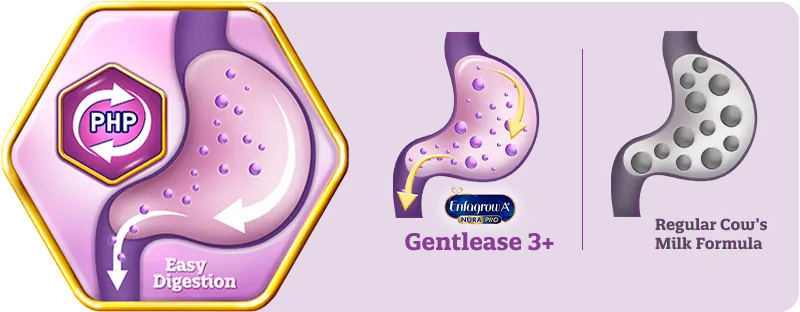Growing children have growing tummies. As a parent, you know that eating the right food is important so that they get the complete nutrients they need for their growth and development. Digestion problems can arise, such as loose bowel movement (diarrhea), gassiness, bloating, or constipation3.
Your child could also experience fussiness where they cry for long periods or colic. This may be the first sign that they have tummy discomfort9. Sometimes, they could experience bloating and gassiness that makes them unsettled.

Photo by Alex Green from Pexels
Oftentimes, your child could have milk intolerance. This can develop as your child gets older, but this shouldn’t stop you from giving milk to your child. It’s an important source of nutrients for them. Milk with smaller proteins or partially hydrolyzed proteins (PHP) can help in your kid’s digestion.
Put together with a balanced diet, you can help ease their digestive system. When your child experiences vomiting or diarrhea, that could be a sign that there’s more to the story. Trust your instincts and consult your pediatrician right away.
Gut Health = Wealth
It’s important to give your child the proper diet for their nutrition and development. The right food comes in fruits, vegetables, as well as milk that you give to your child.
Milk has been and will continue to be an important part of your child’s nutrition. Even if your child eats solid food, milk is a great supplement for other nutrients they need.
What should go into a proper and well-balanced diet for your child?
1. Partially Hydrolyzed Protein (PHP)
Protein is an essential part of your child’s diet but they’re large complex molecules so it might be hard to digest. Despite this, protein is still a key component in child stomach pain management so (PHP) Partially Hydrolyzed Protein could be the answer.
Hydrolysis is a process that chops up protein so that they’re smaller and easy to digest by your child10. Partially hydrolyzed protein is easy to digest and easy to absorb11.

Your child’s transition from pure milk to solid foods can be tricky at first but eventually, you’ll get the hang of what works and what doesn’t. As a parent, you only want the best for your kid. Enfagrow Gentlease 3+ has a unique blend of (PHP) Partially hydrolyzed protein, reduced lactose, and a combination of MFGM* and DHA* – suited for developing tummies*.
2. Reduced Lactose
If your child is prone to tummy aches, they might have a sensitivity to lactose or lactose intolerance. This could lead to problems such as diarrhea, colic, bloating, and gassiness6.
You don’t have to cut out milk in their diet, consider including milk that has reduced lactose to help your kid digest milk better. Lactose is an important part of your child’s development because it provides energy and helps them absorb calcium and iron8.
3. MFGM
Studies show that a well-developed brain creates a domino effect on the entire body, that’s why it’s important to prioritize brain development. You can do this by including MFGM* in your child’s diet with proper nutrition and stimulation4.This is naturally found in milk and is best paired with DHA to supplement your child’s diet.
Enfagrow A+ Four NuraPro and Enfagrow Gentlease 3+ contain both MFGM* and DHA*, important nutrients to support brain and cognitive development together with proper nutrition and stimulation.
4. DHA
Fats are fuel for your child’s body. It helps them grow big and strong, but you have to choose the right kind of fats. Healthy fats help absorb Vitamins A,D,E, and K for a full-rounded meal2. Omega-3 fats are good fats.
There are three important Omega-3 fats – ALA, EPA, and DHA. These are essential in your meal plan as they cannot be made by your human bodies4. DHA is the most important of the Omega-3 fats because it helps in brain development and it may also improve asthma.
To get the benefits of DHA, feed your child fatty fish such as salmon and tuna. They can also be found in some dairy products. Milk with DHA supplements can help complete their Omega-3 needs!
5. Fiber

Lack of fiber can easily contribute to constipation. It’s also a cause of digestion problems that can affect your child’s growth. Foods with fiber are good sources of nutrients and vitamins. Good sources of fiber are fruits, vegetables, nuts, whole-grain bread, and cereals.1
6. Water
Sometimes when you focus on what you feed your child, you forget to fulfill their intake of water. This could lead to constipation where they have hard and dry poop coming out of them. Their bowel movements could also be fewer than usual. Water helps your kid digest food properly and for the waste to leave their body for when they sweat, pee, and poop.
It’s an important part of every diet. It is recommended over soft drinks or sugary drinks which can worsen their tummy aches.
What you give your child is an important decision that can affect their growth and development. Choose what’s best for your child and so, if they continue to experience symptoms of digestion issues such as constipation, diarrhea, vomiting, acid reflux, and gassiness – it’s best to consult your pediatrician to learn more.
Get more digestion articles.Join Club Mama now!
*with proper nutrition and stimulation
References:
- Kids Need Fiber: Here’s Why and How, available at https://www.healthychildren.org/English/healthy-living/nutrition/Pages/…. Accessed on 26 August 2022.
- Fats, available at https://kidshealth.org/en/parents/fat.html#:~:text=Getting%20enough%20h…. Accessed on 26 August 2022.
- 5 Common Digestive Issues in Kids, available at https://www.mysmartclinic.com/blog/5-common-digestive-issues-in-kids. Accessed on 26 August 2022
- What Are Omega-3 Fatty Acids? Explained in Simple Terms, available at https://www.healthline.com/nutrition/what-are-omega-3-fatty-acids#ratio. Accessed on 26 August 2022
- MFGM: Ways to Improve Early Childhood Development, available at https://sg.theasianparent.com/mfgm-fed-children. Accessed on 26 August 2022
- Lactose intolerance: babies, children, and teenagers, available at https://raisingchildren.net.au/guides/a-z-health-reference/lactose-into…. Accessed on 26 August 2022
- Ease the Protein Digestion Issue: Partially Hydrolyzed Protein, available at https://www.enfagrow.com.my/articles/ease-protein-digestion-issue-parti…. Accessed on 26 August 2022
- Calcium (for Parents), available at https://kidshealth.org/en/parents/calcium.html. Accessed on 26 August 2022
- Colic, available at mayoclinic.org/diseases-conditions/colic/symptoms-causes/syc-20371074#:~:text=In%20general%2C%20colic%20is%20defined,or%20an%20expression%20of%20pain. Accessed on 26 August 2022
- Digestion: breaking the large into small, available at https://www.sciencelearn.org.nz/resources/1830-digestion-breaking-the-l…. Accessed on 26 August 2022
- Hoffman JR, Falvo MJ. Protein - Which is Best? J Sports Sci Med. 2004 Sep 1;3(3):118-30. PMID: 24482589; PMCID: PMC3905294, available at https://pubmed.ncbi.nlm.nih.gov/24482589/. Accessed on 26 August 2022
ASC Ref Codes: M041P111022ES, M042P111022ES, M043P111022ES, M044P111022ES, M054P112122ES, M135P112422ES, M047P111022ES, M048P111022ES, M046P111022ES, M136P112422ES, M041P111122ES, M137P112422ES, M042P111122ES, M043P111122ES , M044P111122ES, M045P111122ES, M048P111122ES, M139P112422ES, M035P111522ES, M037P111522ES,M138P112422ES, M032P111522ES, M033P111522ES,M034P111522ES , M132P112422ES, M133P112422ES, M134P112422ES


